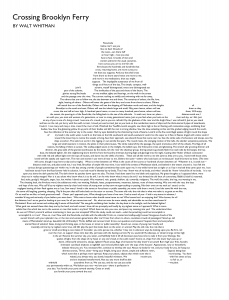Maps create a space for envisioning the world in unconventional, even poetic ways. Such is the case for Gretchen Culp’s map which turns a Walt Whitman poem into a map of Brooklyn. Born in 1819, Walt Whitman was a prolific poet and Brooklynite himself. The poem depicted in the map is Whitman’s Crossing Brooklyn Ferry, originally published in 1856 under the title Sun Down Poem. The Poem turns a seemingly mundane ferry ride from Manhattan to Brooklyn into a, “ Metaphor for the Journey of the Soul”. Just as Whitman is said to have written the poem whilst on a ferry ride, the poem has a sense of movement and transformation. By turning conventions on their head, Culp allows the viewer to perceive the world in a new way. Further, Culp’s map reminds us that maps do not need to be scientific by nature, and can even take on the role of a more artistic agent whilst lending itself to the cultural and historical implications of the land.
This map is worthy of map of the week because of how it makes the viewer see the world in a new way. Through turning a Whitman poem into a map, Culp brings new life to both the poem and the city of Brooklyn. Paying homage to Whitman in this way reminds us of his roots in Brooklyn– almost implying that his presence still lives on in the city in an omnipotent way. The marriage of the land of Brooklyn with Crossing the Brooklyn Ferry allows a piece of Whitman’s soul to live on for the modern reader. Further, Brooklyn’s shape resembles a winged seahorse, lending itself to the map’s depiction of the rich and poetic beauty that is tied to the land of Brooklyn.
Wood once said that, “ Maps present us not with what the world can see, but to point toward a world we might know”. This quote embodies the essence of this map. Clearly, there are not really lines of prose covering the land of Brooklyn. Through metaphorically tying the land to the prose, the map points us towards a “world we may know”. That world is one in which Brooklyn is richly ground in its cultural and poetic history. Through transforming the poem into a map, Culp turns the map into an abstract symbol of the journey, both in soul and physically toward Brooklyn. This rendering of the map goes against conventions of what a map “should be”, as an agent for scientific exploration. Rather than providing geographic “facts”, the map shows us towards the transient, emotional parts of life. Rather than connecting science to the land, the map connects the art of poetry to it. Wood would consider this map to clearly be a product of the knowledge of the world it emerged from. We see this through the map’s tying of prose to the land it was created in. In this way, the map becomes a tool for observing the cultural and historical implications tied to the land.
This map assumes that the reader has background knowledge about Whitman and his role in both American poetry and Brooklyn upbringing. Further, one may argue that this map has similarities to the Mercator Projection in that it emphasizes poetry in a purely American context. Just like the Mercator projection over emphasizes the role of America, Culp’s map is directed towards an American audience and assumes the reader holds American land/history to high importance. The map maker is also from Brooklyn, revealing how she may assume that the viewer of her map is American/Brooklyn based. Further, the map maker is assuming that Whitman was envisioning the land of Brooklyn while writing his poem. The map also romanticizes Whitman’s role in Brooklyn life and ties his soul to the land. In doing so, the map assumes Brooklyn is a special and important place to Whitman, despite his poor and less than ideal upbringing there. Ultimately, this map brings new life to both Crossing Brooklyn Ferry as well as the land of Brooklyn but makes many assumptions in doing so. This map’s playful and unconventional elements makes it a powerful tool in the society it emerged from. Here lies the true power of maps– they shape our perceptions in all realms of life. Whether through art, emotions, or science, maps allow us to spatialize the world in different ways. This map forces us to suspend our disbelief and realize the plethora of roles maps can take on.
Sources:
http://bigthink.com/strange-maps/test-12
Wood, Denis. The Power of Maps. The Guilford Press, 1992

